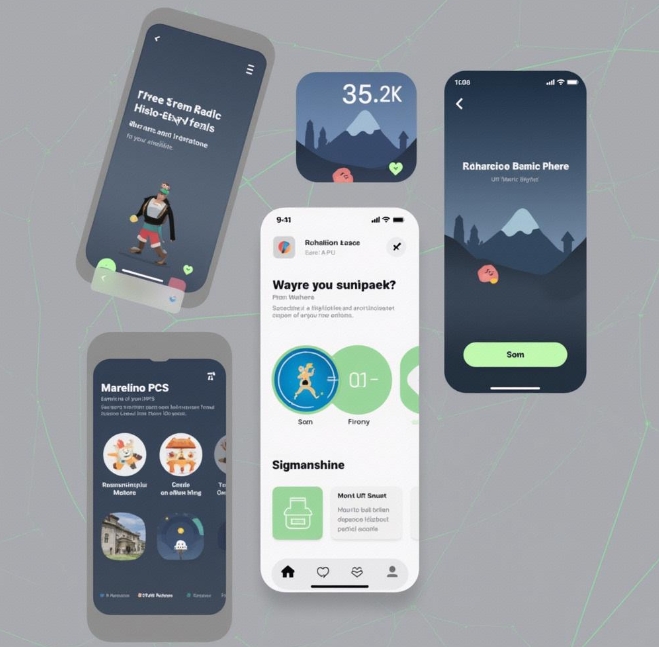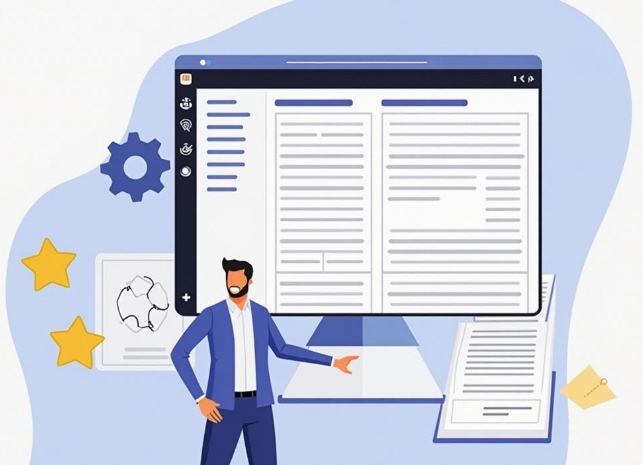UI Design Principles and Techniques in Mini-Program Development
- latest articles
- 1.DApp Development & Customization: Merging Diverse Market Needs with User Experience 2.Analysis of the Core Technical System in DApp Project Development 3.How to achieve cross-chain interoperability in Web3 projects? 4.How does the tokenization of points reconstruct the e-commerce ecosystem? 5.How to Set and Track Data Metrics for a Points Mall? 6.What is DApp Development? Core Concepts and Technical Analysis 7.Inventory of commonly used Web3 development tools and usage tips 8.Development of a Distribution System Integrated with Social E-commerce 9.Six Key Steps for Businesses to Build a Points Mall System 10.What is DApp Development? A Comprehensive Guide from Concept to Implementation
- Popular Articles
- 1.Future Trends and Technology Predictions for APP Development in 2025 2.Analysis of the DeFi Ecosystem: How Developers Can Participate in Decentralized Finance Innovation 3.From Zero to One: How PI Mall Revolutionizes the Traditional E-commerce Model 4.DAPP Development | Best Practices for Professional Customization and Rapid Launch 5.Recommended by the Web3 developer community: the most noteworthy forums and resources 6.From Cloud Computing to Computing Power Leasing: Building a Flexible and Scalable Computing Resource Platform 7.How to Develop a Successful Douyin Mini Program: Technical Architecture and Best Practices 8.Shared Bike System APP: The Convenient Choice in the Era of Smart Travel 9.How to Create a Successful Dating App: From Needs Analysis to User Experience Design 10.From Design to Development: The Complete Process of Bringing an APP Idea to Life
Mini Programs have rapidly emerged in the mobile internet field in recent years as a type of application. Due to their no-download, instant-use nature, they have become essential tools in the daily lives of many users. As Mini Programs become more widespread, UI (User Interface) design plays a crucial role. An excellent Mini Program UI design not only enhances the user experience but also increases user engagement and satisfaction. Therefore, this article will delve into the principles and techniques of UI design in Mini Program development to help developers create more user-friendly and aesthetically pleasing Mini Program interfaces.
I. Basic Principles of Mini Program UI Design
UI design is not just about being "visually appealing"; more importantly, it should enhance the user experience, making operations simple, intuitive, and smooth. Below are some UI design principles that must be followed in Mini Program development:
1. Principle of Simplicity
One of the key features of Mini Programs is convenience and efficiency, so UI design should adhere to the principle of "simplicity." Interface elements should not be excessive, and cluttered designs should be avoided. Too many buttons, icons, or text can make the interface appear crowded and may confuse users in complex operational flows. Therefore, designers need to use reasonable layouts and clear hierarchies to make the interface more concise and intuitive.
The principle of simplicity can be achieved through the following methods:
Reduce Page Elements: Remove unnecessary decorative elements and focus on displaying the most critical functions and information.
Simplify Operational Flows: Minimize the number of clicks required, allowing users to complete their tasks in the shortest time possible.
Clear Hierarchical Structure: Use appropriate spacing and typography to make the page content well-organized and easy to understand at a glance.
2. Principle of Consistency
The principle of consistency is one of the fundamental guidelines in UI design. Elements such as interfaces, buttons, colors, and fonts within a Mini Program should remain unified, avoiding drastically different design styles across pages. If the design style varies significantly between pages and functions, users may feel confused, increasing the learning curve.
Key elements of the consistency principle include:
Unified Design Style: Ensure every interface in the Mini Program follows the same visual style, including colors, fonts, and button shapes.
Consistent Interaction Patterns: Interaction methods across pages should remain consistent, such as button click feedback and swipe gesture responses.
Unified Icon and Text Styles: Icons and text should maintain a consistent style, avoiding the use of too many different icon forms that could disrupt user habits.
3. Principle of Usability
The ultimate goal of Mini Program UI design is to provide users with a convenient operational experience, so usability is crucial. Designers need to consider user needs, ensuring the interface is simple, easy to operate, and easy to understand. Regardless of the user's age or technical background, they should be able to complete their tasks through an intuitive interface.
Methods to improve usability include:
Clear Copy and Labels: Text on buttons, labels, and prompts should be simple and straightforward, avoiding overly technical terms.
Efficient Operational Flows: Users should be able to quickly find the functions they need, and operational paths should be as short as possible, minimizing steps.
Responsive Design: Ensure the Mini Program displays well on screens of different sizes, especially on mobile phones and tablets.
4. Principle of Visual Hierarchy
Good visual hierarchy helps users quickly understand the interface layout and the importance of information. In Mini Program UI design, designers need to use elements such as color, font, size, and contrast to clarify the hierarchical relationships within the interface.
Elements of the visual hierarchy principle include:
Highlight Key Information: Emphasize the most important information or actions in the interface by using larger fonts, bright colors, or animation effects.
Separate Information Areas: Use reasonable layouts and spatial divisions to distinguish different functional modules, avoiding overly dense information.
Guide User Operations: Use visual hierarchy to help users understand the operational flow, such as using "Next" buttons or progress bars to indicate the current stage of the operation.
5. Principle of Adaptability
With the widespread use of smartphones, tablets, PCs, and other devices, the usage environment for Mini Programs has become increasingly diverse. Mini Program UI design needs to have good adaptability, allowing it to adjust dynamically to different devices and resolutions, ensuring users always have a consistent experience.
Methods to achieve adaptable design include:
Responsive Layout: Dynamically adjust the interface layout based on screen size and resolution to fit various devices.
Flexible Images and Media Elements: Ensure images, videos, and other multimedia elements display correctly on different devices without distortion or obstruction of other content due to scaling.
Touch-Friendly Design: Since most Mini Program users operate via touchscreens, UI design should consider finger operation range and precision, avoiding overly small buttons or links.
II. Techniques in Mini Program UI Design
After mastering the basic principles of UI design, we will now explore some specific techniques to help developers achieve better results in Mini Program design.
1. Using Clear Icons and Buttons
Icons and buttons are core elements in Mini Program UI design. They play a crucial role in guiding users to complete operations, so their design must be clear, concise, and easy to understand. For icon design, designers should avoid using overly abstract or hard-to-understand graphics. Common icons should align with user intuition, making it easy for users to grasp their meaning.
Icon Design Techniques:
Intuitiveness: Choose easily recognizable icons and avoid overly complex shapes.
Consistency: Maintain a consistent icon style throughout the Mini Program, avoiding icons with vastly different styles.
Appropriate Size: Icons should be large enough to be easily clicked, especially on mobile devices, to prevent operational difficulties due to overly small icons.
Button Design Techniques:
High Clickability: Buttons should have appropriate sizes and spacing, avoiding overly crowded arrangements.
Highlight States: Buttons should clearly distinguish between different states (e.g., default, clicked, disabled) to facilitate user operations.
Clear and Concise Copy: Text on buttons should be short and meaningful, avoiding lengthy descriptions.
2. Applying Color and Font Combinations
Color and font are important visual elements in UI design. Skillful color matching and font combinations can effectively enhance the readability and aesthetics of a Mini Program interface.
Color Matching Techniques:
Primary Color Selection: Choose one or two primary colors as the base for the interface to increase brand recognition.
Contrast: High-contrast color combinations help improve readability, especially between text and background colors.
Color Psychology: Different colors evoke different emotional responses. For example, blue often conveys trust and calmness, while red signals urgency or warning.
Font Matching Techniques:
Simple Fonts: Choose clean sans-serif fonts (e.g., Microsoft YaHei, Roboto) for body text, avoiding complex serif fonts.
Font Size Hierarchy: Use different font sizes for titles, body text, buttons, etc., to distinguish information levels.
Avoid Too Many Font Types: To maintain consistency and simplicity, avoid using too many font types in the same interface.
3. Using Animations and Transition Effects
Animations and transition effects can effectively enhance the user experience, adding fun and smoothness to interactions. However, excessive animations may distract users and reduce operational efficiency, so they should be used cautiously.
Animation Techniques:
Simple and Smooth: Animations should be simple and smooth, avoiding overly complex or slow animations that might cause delays during user operations.
Use Animations at Key Points: Incorporate appropriate animations at key operational points (e.g., submission, page transitions) to enhance user confirmation of the operation result.
Feedback Animations: Provide timely feedback during user operations, such as scaling effects after clicking a button or spinning effects during page loading.
4. Providing Clear Feedback Information
Mini Program UI design needs to provide timely and clear feedback during user operations. This includes not only visual feedback (e.g., button highlighting, pop-up prompts) but also multi-sensory feedback forms like sound or vibration. Through these feedback mechanisms, users can clearly know whether their operations were successful.
Feedback Information Design Techniques:
Immediate Feedback: Users should receive feedback immediately after each operation to avoid leaving them in an uncertain state.
Clear Prompt Messages: Error messages, loading prompts, etc., should be concise and clear, avoiding vague or unnecessary terminology.
Friendly Prompts: Feedback language should avoid overly harsh or negative wording, using encouraging and positive language to guide users.
III. Summary
In the process of Mini Program development, UI design is not just about visual presentation but also a core element in enhancing the user experience. By adhering to design principles such as simplicity, consistency, and usability, and combining them with practical design techniques, developers can create Mini Program interfaces that are both aesthetically pleasing and user-friendly. Good UI design can significantly improve user satisfaction, thereby increasing the Mini Program's activity and retention rates. In the future, Mini Programs will continue to play a role in more fields, so the importance of UI design will keep growing, making it worthy of further exploration and practice by developers and designers.
-

How to Increase User Stickiness and Activity Through Mini Program Development
With the development of the internet and mobile internet, mini-programs, as an e···
-

How can mini-program development assist in corporate marketing and e-commerce transformation?
In today's rapidly evolving mobile internet landscape, corporate marketing and e···
-

Offline Functionality Design and Data Synchronization in Mini-Program Development
With the rapid development of mobile internet, mini-programs, as a lightweight a···

 Blockchain
Blockchain












